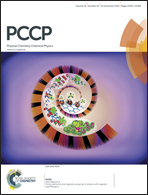Ligand exchange in quaternary alloyed nanocrystals – a spectroscopic study†
Abstract
Exchange of initial, predominantly stearate ligands for pyridine in the first step and butylamine (BA) or 11-mercaptoundecanoic acid (MUA) in the second one was studied for alloyed quaternary Cu–In–Zn–S nanocrystals. The NMR results enabled us to demonstrate, for the first time, direct binding of the pyridine labile ligand to the nanocrystal surface as evidenced by paramagnetic shifts of the three signals attributed to its protons to 7.58, 7.95 and 8.75 ppm. XPS investigations indicated, in turn, a significant change in the composition of the nanocrystal surface upon the exchange of initial ligands for pyridine, which being enriched in indium in the ‘as prepared’ form became enriched in zinc after pyridine binding. This finding indicated that the first step of ligand exchange had to involve the removal of the surface layer enriched in indium with simultaneous exposure of a new, zinc-enriched layer. In the second ligand exchange step (replacement of pyridine with BA or MUA) the changes in the nanocrystal surface compositions were much less significant. The presence of zinc in the nanocrystal surface layer turned out necessary for effective binding of pyridine as shown by a comparative study of ligand exchange in Cu–In–Zn–S, Ag–In–Zn–S and CuInS2, carried out by complementary XPS and NMR investigations.


 Please wait while we load your content...
Please wait while we load your content...